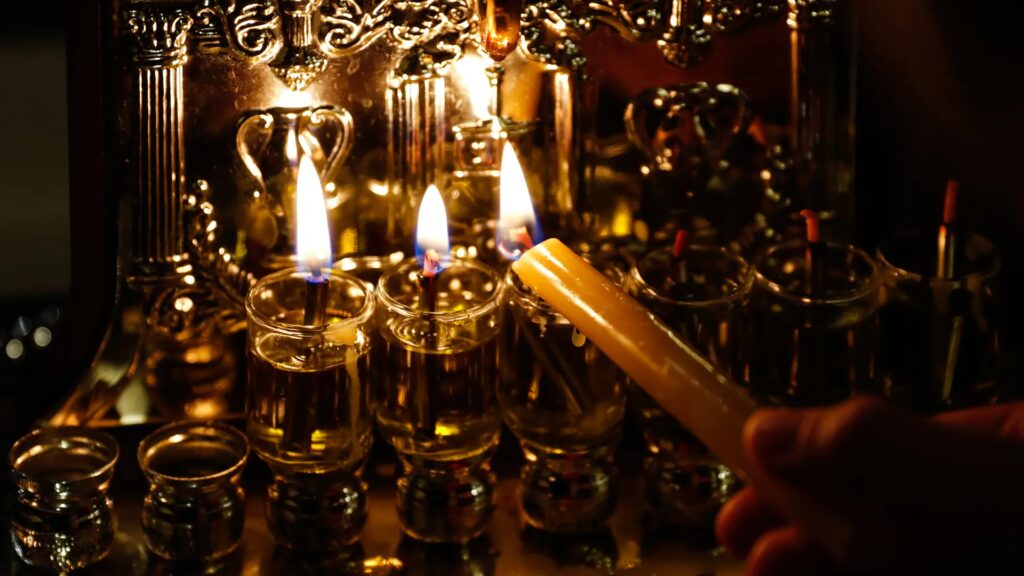
The eight-day Festival of Lights marks an event dating to the second century B.C.E.
- What Does Hanukkah Celebrate?
Hanukkah celebrates the rededication of the Second Temple of Jerusalem during the second century B.C., following the triumph of a small group of Jewish rebels, known as the Maccabees, against their oppressors the Greek-Syrians, who had defiled the temple by erecting an altar to Zeus and sacrificing pigs within its sacred walls. In order to rededicate the temple, the Maccabees had to light a menorah that would burn within the temple at all times. However, they only had enough pure olive oil to last for one day. Miraculously, the oil burned for eight days, leaving time to find a fresh supply of oil.
2. Menorah or Hanukkiyah?
A menorah, the Hebrew word for lamp, has seven branches. It was originally used in the First and Second Temples in Jerusalem. Menorahs were lit daily using olive oil of the purest quality. A hanukkiyah is a Hanukkah menorah used specifically to light the candles (often used today instead of oil) on Hanukkah. With nine branches, it is lit each night to celebrate the miracle of oil lasting eight days. Despite these differences, today hanukkiyahs are commonly referred to as menorahs.
3. How to Light the Menorah.
There are very specific rules about lighting a menorah; luckily most of them rely on simply knowing your left from your right. The menorah has nine branches, one for each night of the Festival of Lights, plus a shamash, meaning helper or attendant, which is lit first and then used to light the other candles. The shamash always sits a bit higher or lower than the rest of the candles so as to not get confused with the others. The candles are placed on the menorah from right to left, the same direction in which one reads Hebrew. However, when lighting the menorah you move in the opposite direction, using the shamash to the light the candles from left to right. Confusing? Eh, do your best.
How many candles will you need? 44. Each night a new candle is added to the menorah, plus a shamash, and burned all the way through. But don’t worry, there is no need to count; if you buy a box it will come with 44.
4. There Is a Height Limit for Menorahs.
There is a clearly defined height limit for menorahs of 32-feet-tall. In New York City, two menorahs rival each other for height. One is in Grand Army Plaza, Brooklyn and is claimed to have a shamash that is six inches higher than its Manhattan competitor located on the corner of Fifth Ave. and 59th St.
5. The Traditional Use of Oil Even Applies to the Holiday’s Foods.
The miracle of the oil lasting eight days is not only celebrated through the lighting of the menorah, but also in the traditional foods that are eaten. Two of the most popular dishes, latkes (potato pancakes) and sufganiyot (jelly donuts), are both deep-fried in oil. While the tastiness of these foods are reason enough to eat them, it’s the oil used to cook them that make them a staple for most Hanukkah celebrations.
6. Dreidel, Dreidel, What?
Dating back to before the Maccabee revolt, dreidels (four-sided spinning tops used to play a gambling game) were originally used as a type of decoy after the Greek-Syrian armies of King Antiochus IV Epiphanes enacted a series of laws outlawing many Jewish religious practices. The Jewish people simply moved their studies of the Torah underground, pulling out their dreidels and pretending to play games to confuse soldiers. Since then, dreidel has been resurrected as a fun game played during Hanukkah for chocolate coins called gelt, to commemorate this time. Each side of the dreidel has a different Hebrew letter, which tells the player how much to put in, or take out, of the pot. Together, these four letters form the acronym for “Nes Gadol Hayah Sham,” which means “a great miracle happened there,” referring to the miracle of the oil lasting eight days in Israel.
7. Why is Hanukkah Celebrated on Different Dates?
While it rarely seems to be celebrated on the same day, on the Hebrew calendar, Hanukkah always falls on the 25th day of the month of Kislev. The first day of Hanukkah can come as early as November or as late as the end of December, which means occasionally Hanukkah overlaps with Thanksgiving or Christmas. The last time we celebrated Thanksgivukkah was in 2013. Hanukkah and Christmas saw duel celebrations in 2005 and will converge again in 2024. Due to the difference in calendars, every year Jewish people around the world—and their gentile friends— are left Googling the start date for Hanukkah.
8. How Do You Spell Hanukkah Anyway?
There isn’t one right way to spell Hanukkah. If you are confused, you can blame transliteration. Originally written in Hebrew, a character-based language, the variations arose when the word had to be written in English, an alphabet-based language. Lacking exact English equivalents to the Hebrew sounds led to the many spelling variations we see today: Hanukkah, Chanukah, Hanukah, Hannukah, Chanukkah. In English, the different spellings don’t affect the pronunciation. So when writing Happy Hanukkah, have no fear, pick your favorite.
